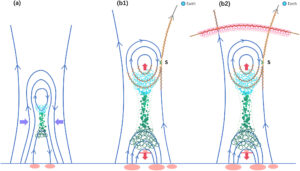Welcome to Team 581: Understanding the release of hard X-rays, type III radio bursts and in-situ electrons in solar flare
Our Team will meet in ISSI-Bern and ISSI-Beijing in 2024. Team members can be found Here.
In this project we will examine how electrons are accelerated in impulsive SEP events and how they subsequently propagate in the solar wind

Solar electron events are common phenomenon observed in interplanetary space. In-situ electrons from <1 keV to >300 keV are often observed in these events with an occurrence rate near the earth of 190 events per year during solar maximum and ~10 per year during solar minimum. A majority of these events is related to small flares with no accompanying coronal mass ejections (CMEs),
suggesting that the underlying acceleration process is confined both spatially and temporally. Once accelerated at the flare site, electrons propagate out along open magnetic field and excite type III radio bursts. Observations of these in-situ electrons (time intensity profiles and particle spectra) and type III radio bursts can put strong constraints on the underlying acceleration process at the flares. It also helps to understand the configuration of the interplanetary magnetic field, and in particular, how does it differ from the nominal Parker field.
Since 2020, after which solar activity picked up noticeably, many HXRs, type III radio bursts, and in-situ electron events have been identified by two recently launched spacecraft: Parker Solar Probe (PSP) and Solar Orbiter (SolO). In many instances, the distances between the s/c and the Sun were much closer than 1 au. This means the uncertainty of the arrival time of electrons, which is affected by pitch angle scattering during electron propagation is much reduced comparing to previous observations made at 1au, by, e.g. Wind and ACE missions.
Such an observational advantage implies that the above-mentioned constraint on electron acceleration at flares will be further strengthened, thus greatly advancing our understanding of solar flares. The much reduced uncertainty will also imply that we will get a better understanding of the IMF configuration.
We plan to perform comprehensive investigation of impulsive solar electron events from PSP and SolO observations. Observations of HXRs, type III radio bursts and in-situ electrons will be combined together to understand the energy dependence of the release time of energetic electrons in solar flares, and the configuration of IMF. A major portion of the proposed study will be on data analysis of PSP and SolO data. This will be further assisted by numerical simulations addressing the pitch angle scattering of energetic electrons in the solar wind. To achieve our goal, a group of experts in solar physics and heliosphysics, including theorists, modelers, and observers is amassed.
